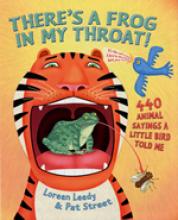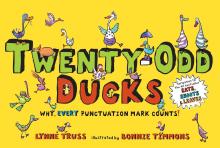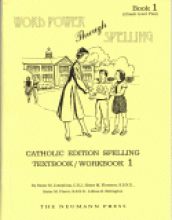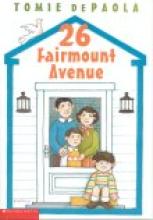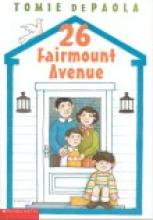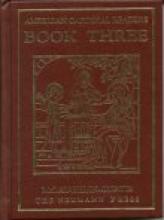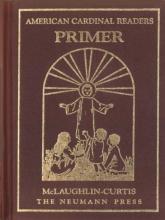Language Arts
There's a Frog in My Throat
Twenty-Odd Ducks
Lynne Truss does it again, this time stressing the correct use of the hyphen, parenthesis, question and exclamation marks and also more comma use. I feel that my younger kids will have a wonderful and visual grasp of punctuation as they grow up exposed to Truss' humor and fresh approach to grammar! If you haven't enjoyed her first punctuation picture books, don't miss them: Eats, Shoots and Leaves and The Girl's like Spaghetti!
Word Power Through Spelling: Catholic Edition
First Lesson Word List: a, big, dog, is, my Final Lesson Word List: way, glad, happy, how, ten, stand, very, name, walked, train Weekly lessons introduce a new word list (the number of words in the list increase as the book progresses) and gives practice writing and recognizing the words in the context of sentences and to describe illustrations. Some handwriting practice is included (including a page with directions for printing, and later in the text one for writing cursive letters). The text works a bit on the meaning of words but doesn't get into phonetic rules. A special format for keeping track of and practicing problem words allows the student to additional review throughout the text for problem areas. There are some instructions to the teacher at the beginning of the book which outline "how to study a missed word" and how the lesson plan is supposed to work. Directions to the students are intermixed with the text, but I found it difficult in a few places to determine what was to be done.
The text reminds me of the Rod and Staff workbooks, but with some Catholic content.
WriteGuide.com Individualized Writing Course
We've all heard the whining and complaining that can come with teaching composition. Many children just refuse to make the effort to write, and when they finally do finish an assignment their parents agonize over how to grade the composition. Having heard the writing complaints for years, I am excited to report that there is now a solution in WriteGuide.com.
Last month two of our children participated in an online tutorial through WriteGuide.com. Wait–before you stop reading because "those things are too pricey for our family," let me assure you, this tutorial is very affordable. Our children had a great time working on several different compositions that were a part of their tutorial and anxiously waited each day for an e-mail response from their tutor. Writing has never been so easy in our home.
WriteGuide.com provides individualized writing courses for as short as 1 month or as long as 12 months. The parent determines the goals of the course and, along with the tutor (all teachers hold masters degrees and have extensive teaching experience) the course content is decided. The students may either have "from scratch" writing assignments, as my children did, or follow a curriculum that the family is already using. The tutor contacts the parent through e-mail to establish the relationship and then the course begins. Each day the student submits his assignment and receives a reply that same day from his teacher. This is not an abstract relationship or one based on forms; the student chats with his teacher through e-mail and receives a personal, friendly reply that motivates the child while at the same time instructing him on style, grammar, mechanics, etc. as they directly relate to his writing assignment. You can see samples of e-mail exchanges between students and teachers at http://writeguide.com/samples.htm
Our online tutorial was a month long and went from the 2nd of one month until the 2nd in the next calendar month. Rather then have one child do the tutorial for the entire month, our 15-year-old son worked with the teacher for three weeks and our 12-year-old daughter worked with her for the remaining 5 or 6 days. The variety of assignments that WriteGuide will allow is quite varied. While working with the teacher, our son wrote a six-page research report on religious symbolism along with a complete bibliography. (What a relief not to have to teach that myself!) He also wrote the beginning of a fantasy novel. Our daughter, who normally hates writing, cheerfully wrote an essay about the Hittites and is begging to do another writing tutorial. I am amazed at how much her writing improved in just one week's time. The teacher was flexible and enthusiastic throughout the course and we were especially happy to learn that she was Catholic. WriteGuide.com employs several Catholic teachers and matches them up with Catholic families upon request.
I'm very impressed with the quality of WriteGuide.com and highly recommend it for both home school families and public school students. You'll be surprised at how much your child will learn in just one month.
Writing Strands
The Writing Strands program focuses on the structure of writing by teaching the student to organize his thoughts before writing. Many of the ideas the author uses are found in other English programs, such as Voyages in English, but in WS they are presented in a more systematic fashion with each lesson building on preceding lessons. The lessons are written for the child to read and do independently, with the parent checking work occasionally. WS is very straightforward and directs the child to write about specific topics. I liked this approach, but after working through half of WS3 my son was less then enthusiastic about continuing. Some of the topics he couldn't relate to and others were boring. While his writing was organized, I didn't see any improvement in sentence complexity. I continued to search for a writing program that would work for our family and discovered the Institute for Excellence in Writing.
26 Fairmount Avenue Series
- 26 Fairmount Avenue
- Here We All Are
- On My Way
- What a Year!
- Things Will Never be the Same
These books also make delightful read-alouds.
26 Fairmount Avenue
Primarily, his Catholic faith is witnessed through his family's relationships with one another, as well as their friends and neighbors. For instance, Tomie's relationship with his great grandmother is a beautiful example of a young child loving and respecting an elderly person. Tomie likes to spend time with his great grandmother. "...my Nana upstairs was a special person to me. I loved her and every Sunday I spent all my time with her." This is quite amazing for a child his age when you realize that Nana upstairs is so old that she has to be tied into a chair so that she won't fall over.
Written with warmth and amusing anecdotes, this book is a delight to read. I highly recommend reading his numerous other books as well.
If you are interested in reading more about his childhood, Nana Upstairs and Nana Downstairs is about his visiting his great grandmother. Now One Foot, Now the Other and Tom are about his grandfather. The Baby Sister is about his joyful anticipation of his baby sister and the difficulties of waiting for her arrival. The Art Lesson is about his love of art, his desire to be an artist someday, and his hope to take a "real" art lesson in school with a "real" art teacher. All these books are picture books, expressing a child's point of view with reverence for others and respect and joy for life.
This is a really delightful little book. In addition to its historical value and charming family relationships, the author's experiences as a young boy who loved stories and was frustrated by his kindergarten class that wouldn't teach him to read and the changes made to his favorite stories in movie form will be easy for many homeschooled children to relate to. - Alicia Van Hecke (1-4-01)
American Cardinal Readers
The American Cardinal Readers are Catholic Readers originally published around 1930. They were reprinted in 1996 by Neumann Press in very nice hardcover editions. This series is quite popular among Catholic homeschoolers. They are a little more enjoyable and more engaging than the Catholic National Readers, and perhaps more beautifully written (in the way that older books tend to be) than the Faith and Freedom Readers.
American Cardinal Readers: Primer
This book is a chapter story about a family that goes to visit the grandparents on the farm. The parents tell stories of Jesus and Mary. Some of the chapters are "Baby's Angel", "The First Christmas", "A Ride to the Farm". There are twenty chapters total. So each chapter is about 5-10 pages. There are black and white pictures with the stories that are lovely. The type is easy to read.
Additional Comments: Unlike the Catholic National Readers, the primer and early grades are not phonetically based. The child will need quite a bit of basic phonics work before starting the primer as they will encounter somewhat advanced words such as "grandmother" and "grandfather" in the first lesson. Apparently, these were designed to be learned as "sight words". (Alicia Van Hecke, 3-24-01)

